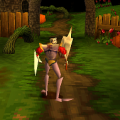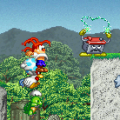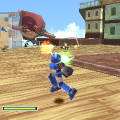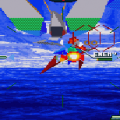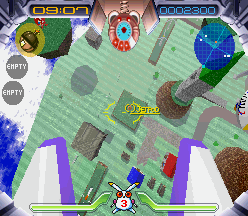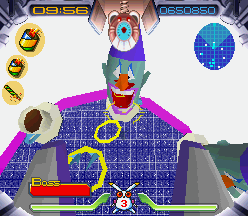A well-executed platformer always has a certain elegance. You run, you jump, possibly throw a fireball at your enemy. There are numerous complications that have been introduced over the years, but there’s a reason the genre is so charming: it’s intuitive. You press left, and your character moves left. Another button makes them jump. Usually, there’s an avatar that is humanoid.
However, this is mostly true for 2D platformers. When pushed into the third dimension, gameplay becomes exponentially trickier for developer and gamer alike. Why? Let’s compare the differences between 2D and 3D platformers. Below is an illustration of a 2D platformer.
As you can see, in a 2D playing field it’s fairly easy to judge whether a player avatar is able to jump from one platform to another. Now below is an illustration of what happens when you convert the gameplay to 3D.
Would Sonic jump off the platform to his fiery death or land safely? Adding in a third dimension makes platforming a much more subjective experience. The human mind calculates depth by having two “cameras” that are situated relatively close to one another (i.e. your eyes). This process, stereopsis, allows humans to accurately triangulate the distance between objects and themselves with a high-level of accuracy. The process is more effective when objects are closer to the person. Thus, when there is only one “camera” – whether that be eye, television monitor, or painting – it is much more difficult for the viewer to judge distance. This is fine when the viewer is engaged in a passive experience, like a movie, but becomes problematic when the experience is participatory.
And this is the problem that game developers encountered in the mid-nineties. The PlayStation, N64 and Saturn were on the market and all three were capable of producing polygon-based three dimensional models, a feat that was difficult on older consoles. Thus, 3D gaming was both novel and revolutionary for the home console market. And so the scramble to create 3D versions of popular genres began in earnest.
Super Mario 64 standardized how the 3D platformer could be done successfully, by approaching this issue in a very logical way. During much of the game the environment is mostly uncomplicated – hard to fall off of, flat. The player can roam unfettered and the camera typically can be controlled. During sections where depth perception is needed, the camera fixes itself into a position that eliminates the z-axis. Thus, a 2D environment is simulated. And, as it is true to all platformers before it, the game is kept in a third person perspective.
What makes the Jumping Flash! series so interesting is that it deals with the issue of depth perception in a 3D environment in a different way. Instead of eliminating the z-axis, the x-axis is given a very clear indicator. All of the Jumping Flash! games are played from a first-person perspective. The player takes the role of Robbit, a rabbit shaped mech, that is able to jump three times in succession. The camera perspective stays level during the first jump, but once Robbit double jumps the camera pans down and is brought parallel with the floor. The y and z axes become the flat 2D field that is recognizable. As Robbit springs further into the air, objects become smaller on the screen. As he plummets towards the ground, objects become larger. This constant movement is brilliant, because it creates a senses of triangulation, thus an easily graspable sense of depth is simulated.
Jumping Flash!‘s charmingly demented plot is relayed to during the opening CGI video. The evil scientist Baron Aloha has taken chunks out of the earth using giant tentacled robots to turn into his own private resort. Universal City Hall (the most confusingly named organization in the galaxy) sends in Robbit, the robotic rabbit, to defeat Baron Aloha and recover the lost chunks of earth.
Characters
Robbit
A robotic rabbit who works for Universal City Hall. He has the ability to triple jump and fire lasers. His robotic stoicism is accentuated, because, like all good video game heroes, he does not speak.
Kumagoro
Robbit’s onboard computer that comments on the action. He narrowly skirts the dreaded 90’s trait of “attitude.” Though his voice is grating, the production team gets props for the fact that his commentary is infrequent and only consists of four words at a time. And his cry when Robbit accidently falls to his death is hilarious. (voiced by Luke Morris)
Baron Aloha
Evil astrophysicist and landgrabber extraordinaire. Baron Aloha likes to scream things like “You cannot understand the power of science!” Apparently he appreciates relaxation as his evil plan was enacted so he could have a private resort to relax at. You can tell he’s no good because of his monocle and hawaiian shirts. In Jumping Flash! 2, he inexplicably gains a German accent. (voiced by Brian Bowles)
MuuMuus
These creatures are Baron Aloha’s henchmen. In their free time they like to hang around in Japanese-style pubs and get drunk (or drink “Root beer fizzes” in the American localization). On the game map, MuuMuus represent boss battles. Also, you’ll see pictures of them all over the stages. Strangely, you never encounter actual MuuMuus during gameplay. (voiced by Lorelei King and Alan Marriott)
The game consists of six worlds that are broken up into three stages. The first two stages require you to gather four “jet pods” and then make it to exit before the ten minute timer runs out. The third level consists of a “boss battle.” X allows you to jump, Square shoots your laser and O shoots special weapons that you can pick up throughout the course of the stages. In the upper left hand corner of the screen is a radar with a very counter-intuitive color system. White dots indicate enemies; yellow dots indicate Jet Pods and red dots are power-ups.
Jumping Flash! is often described as a “first-person platformer,” which is completely accurate. But another way to describe Jumping Flash! is to say that it’s an FPS with the combat elements de-emphasized. The general mechanics are like a first person shooter. Though Robbit’s movements are tank-like, they are very precise. The yellow cursor in the middle of the screen accurately pinpoints where Robbit is going to land, making jumping onto small platform intuitive and easy. He can walk across narrow beams without accidently falling off. Robbit is not pushed back if hit by an enemy and when he jumps onto an enemy’s head he is bounced directly upward instead of at an angle, which eliminates many instances of “easy” deaths. While not “realistic,” these mechanics keep the player from needlessly being pushed to their death.
Exploring the game world is the most thrilling part of the game. Every world has a loose theme: town and lava for World 1, Egypt for World 2, Amusement park for World 3, City for World 5, Space Station for World 6. Every stage has uniquely modeled objects that act as the scenery. You jump from blimp to blimp to make it to higher levels in 2-4. There is a set of train tracks that has an abandoned train on it. In the lava level there is a fry pan with a boiling egg in it. A construction crane acts as a ramp in the city level. And while these objects don’t change the gameplay, they certainly give each level a slightly different flavor.
Most of the stages are stacked in layers, where the player must continually jump to higher levels to reach objects and Jet Pods. There are however, two levels where Robbit is enclosed, so he can’t jump. These actually end up being the most enjoyable levels, as Robbit no longer has his most Also in Stage 4, Robbit must navigate a series of fast-moving walkways in order to advance.
Robbit is given a slew of power-ups, which are either found around the stage or acquired when enemies are killed. Standards such as additional health, additional time on the clock, and invincibility (which comes in the form of a “powerpill” that induces a psychedelic experience). There is also the “time stop,” which stops the clock, freezes all enemies, powers up the radar and paints the screen in a sepia tone (like you’re stuck inside a painting). Weapon power-ups come in the form of fireworks: roman candles, cherry bombs, spinning spirals and rockets.
Finding the Jet Pods isn’t terribly difficult. They’re often in high or out of the way locations, which take time, rather than skill, to acquire. Robbit’s radar pinpoints the location of the pods. Also, when you’re within a certain distance and staring in the direction of the pods or the exit, a marker will pop up on the screen. If you are still having difficulty figuring out where the pods are located, once the timer hits the three minute mark the pods will be highlighted on the radar. this also happens if the time stop power-up is found.
The bosses are not particularly memorable or difficult. All of the bosses follow very obvious patterns and often the player has to jump on the boss’s head while firing Robbit’s laser to defeat them. Though the tea cup genie in 2-3 and the reassembling blocks boss in 4-3 are both interesting to look at. The coolest boss battle is stage 6-2 where you fight an evil Robbit. He has all the same abilities as the player (and tiny rabbit henchmen), and is completely ruthless when he fights you. The final boss, Baron Aloha in a battle suit, is laughably easy. The most common complaint leveraged against Jumping Flash! is that it is entirely too easy. Even though there’s a timer, it’s quite generous and only stupidity on the player’s part ever makes it an issue.
The enemy AI is lacking. Most of the enemies lazily wander around (with the exception of the annoying homing-missile firing creatures) and occasionally attack in your general direction. Since the object is to explore and find jet pods, rather than “rescuing the princess”, nothing ever seems terribly imperative, even when you are fighting a boss. The exception to this is the boss fight in World 6-2. There, you fight a black version of Robbit in a coliseum surrounded by a screaming crowd. Unlike most of the bosses, whom just have attack patterns, this enemy follows your movement and shoots at you when you’re in the sky. It’s a pretty thrilling fight, as the evil Robbit is pretty intelligent.
But since the enemies are nuisances, rather than legitimate threats, it ends up making the power-up system somewhat superfluous. The extra weapons you can throw out are pretty cool, but you’re never attacked by enemies in groups or enemies where you need extra fire power. Is it fun to throw a giant cheery bomb at your enemies? Yeah. But it doesn’t feel dominating or as fun, like power-ups do in, say, Super Mario. The best way to describe Jumping Flash! is that it’s a pleasant experience. However, pleasant is not what most people are looking for from platformers. They’re looking for thrilling.
This is remedied somewhat in the post-game. When all six worlds are defeated an “extra mode” is opened. This is essentially an arranged mode, where the Jet Packs and exits are placed in different spots, and new scenery elements are placed into the stages. The time for completion is also drastically reduced to three minutes for world one and five minutes for all the rest of the worlds. Interestingly while there are stop time power-ups, they no longer function in the same way. Enemies and moving platforms are still frozen, but the time limit clock still counts down.
As is to be expected from a first gen 3D game, everything is made from chunky polygons. However, the production team used a variety of techniques to keep everything from looking drab. Also, there are unique textures that are made out of sprites, such as the hieroglyphics in the pyramid level and the exit sign on all of the launch pads.
Between each level is a short CGI movie of Robbit being launched from a space ship into the next game world. Though these scenes are almost identical, the production team uses a different angles for each one and took the time to full model each of the worlds in the cut scenes. It’s a very thorough and odd touch. For being a first generation PlayStation game, the CGI work still holds up considerably well. Grass has little dark green star patches. In the space level, the sky and clouds are actually below the environment while the rest of the screen is pitch black. This gives the impression that it is taking place in the upper levels of a planet’s atmosphere, which is very cool indeed.




















